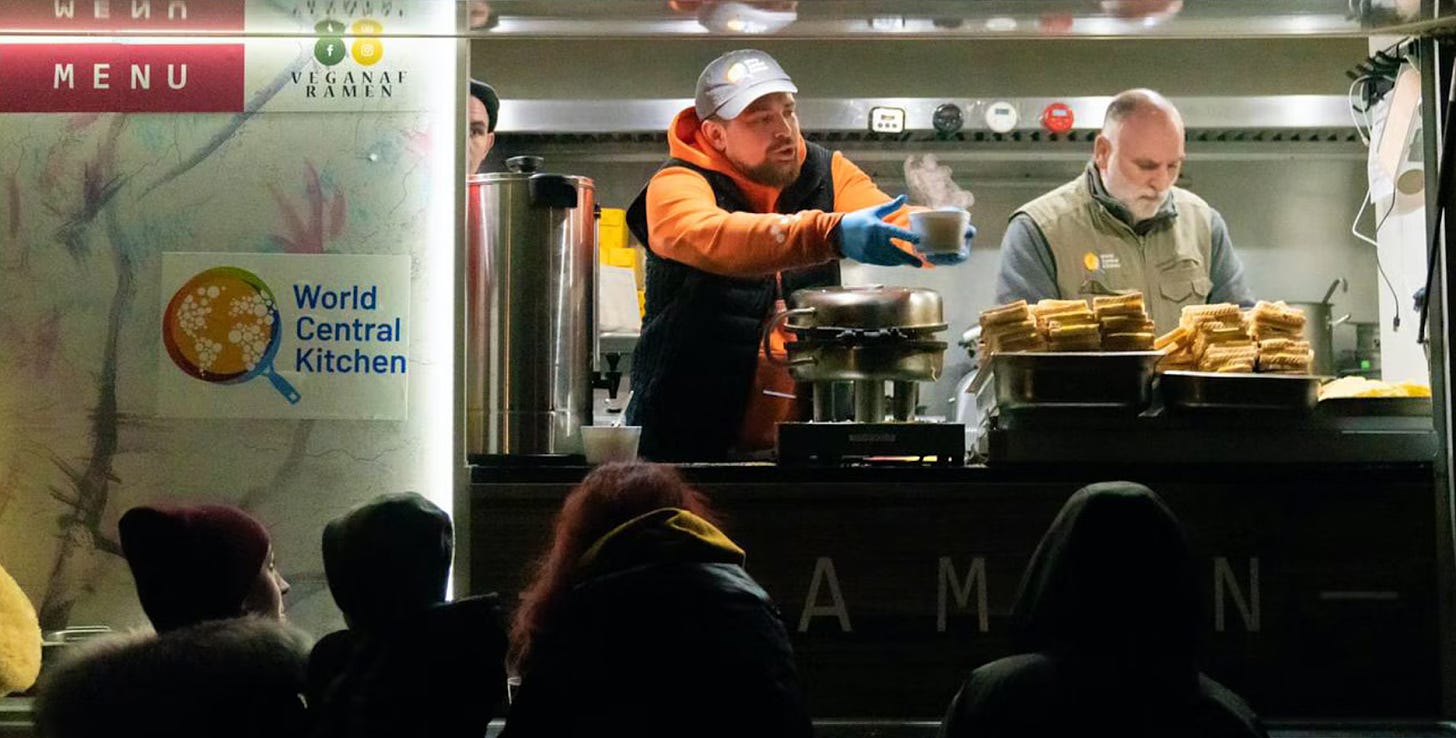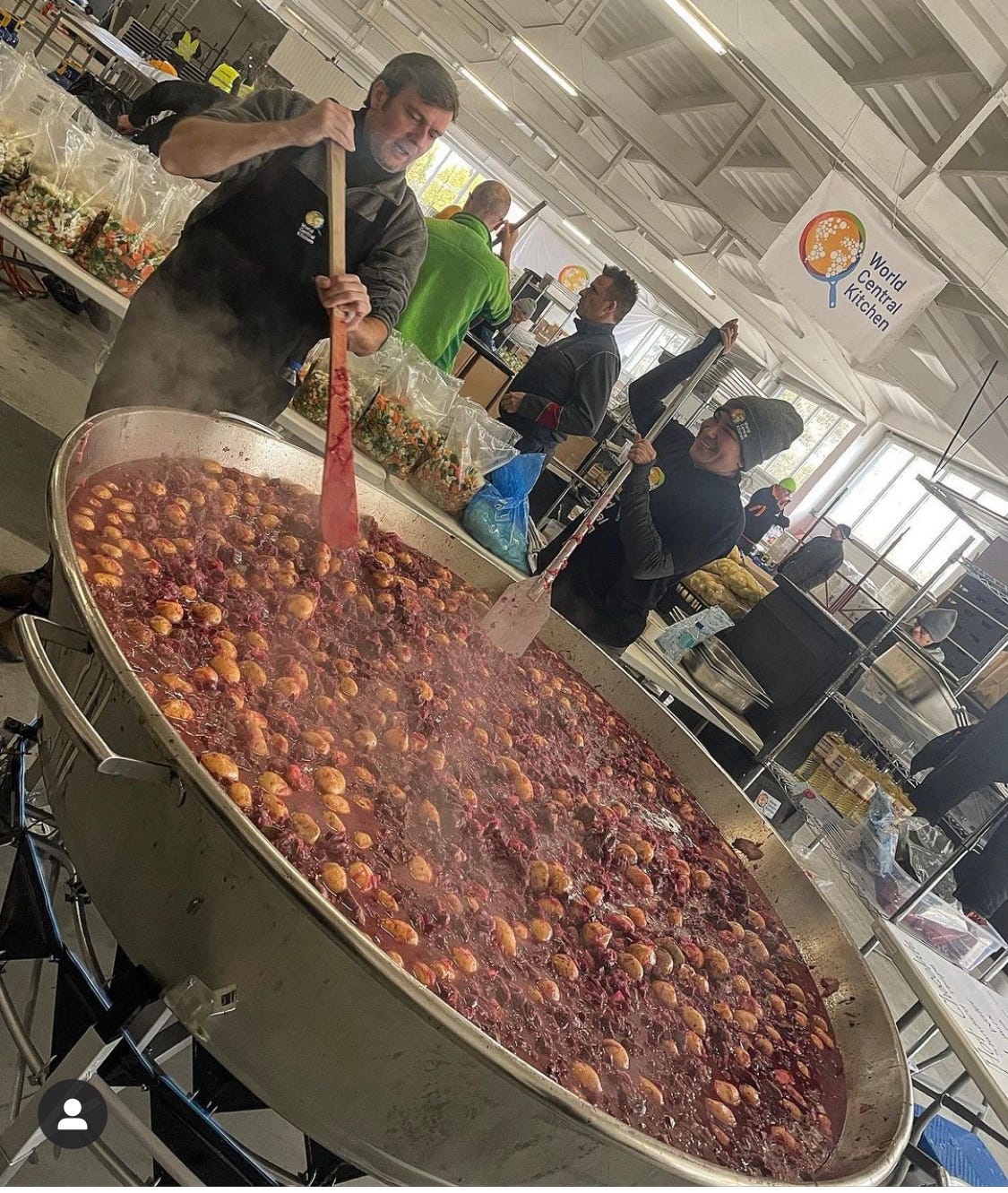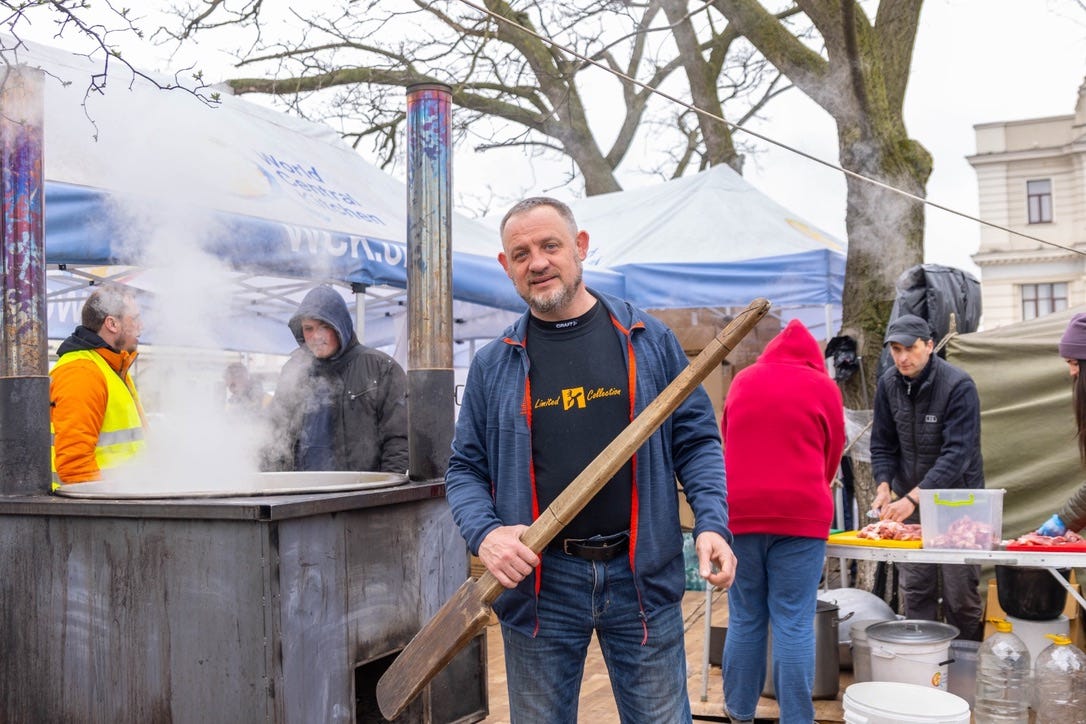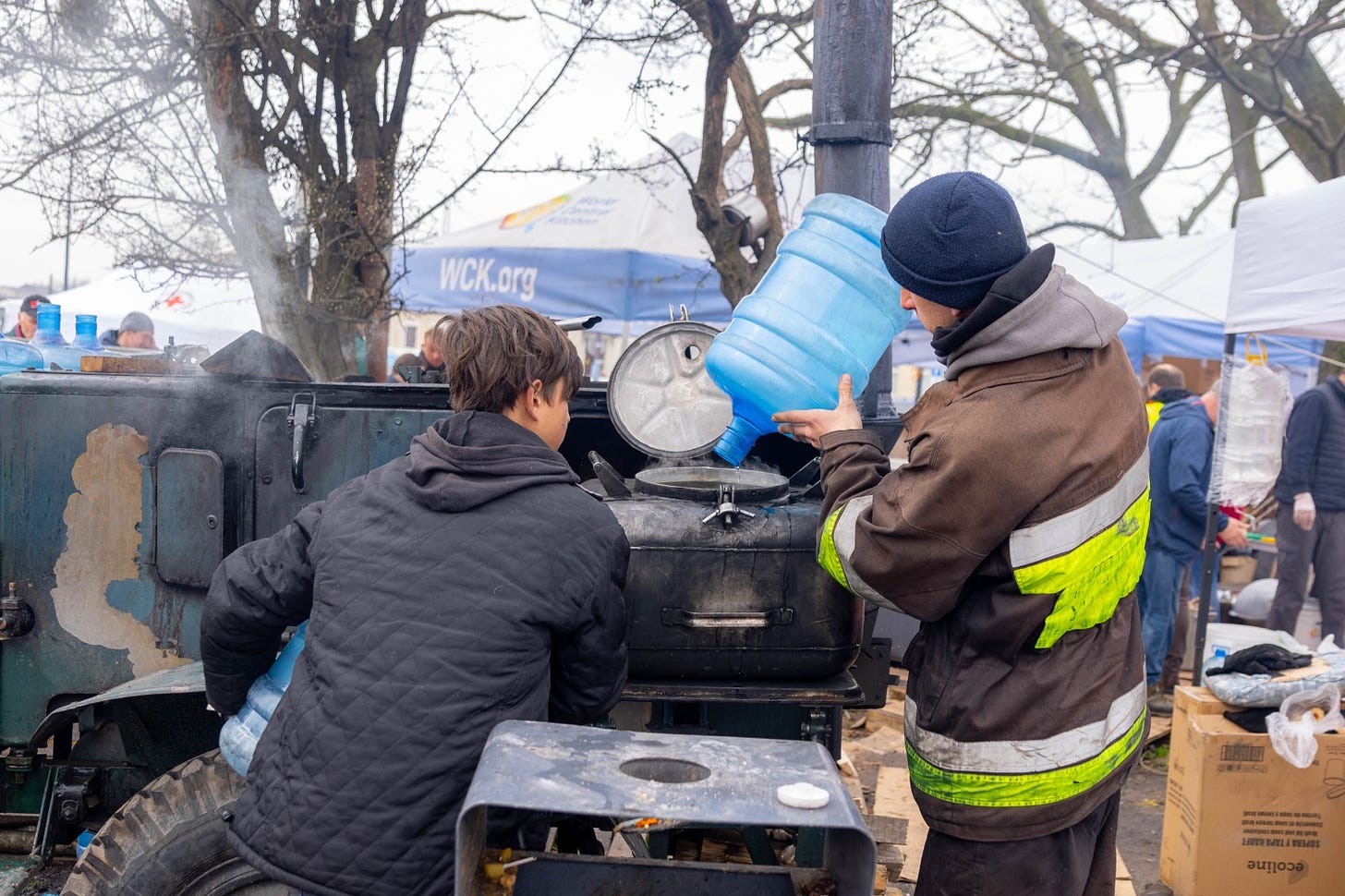

Behind the Scenes: The pots, pans, and people that make millions of meals
source link: https://joseandres.substack.com/p/behind-the-scenes-the-pots-pans-and?s=r
Go to the source link to view the article. You can view the picture content, updated content and better typesetting reading experience. If the link is broken, please click the button below to view the snapshot at that time.
Behind the Scenes: The pots, pans, and people that make millions of meals
Our recipe includes giant paella pans, combi ovens, and a lot of love
Ukraine is many things to me. It’s a humanitarian crisis, affecting the lives of millions of families. It’s our biggest operation in World Central Kitchen history. It’s also our first war zone. But, in my brain, it’s much more simple.
This is what we must do.
I’m just a cook. I didn’t graduate high school. I didn’t even finish culinary school.
But I don’t understand why the world isn’t doing more to stop Russia and help the people of Ukraine.
We don’t sit around and plan at WCK. We start cooking. Then we cook more.
Within hours of the invasion of Ukraine, we quickly set up at the eight border crossings with Poland.
Chefs for Ukraine has grown unbelievably quickly. To date, we have distributed more than 31.1 million meals throughout the region,almost half in Ukraine alone. We are currently averaging 340,000 meals per day, with 15.5 million pounds of food transported across eight countries: Ukraine, Poland, Germany, Hungary, Moldova, Romania, Slovakia, and Spain.
Subscribe to Longer Tables with José Andrés. Until Dec. 31, 2022, 100% of our net subscription revenues will be donated to World Central Kitchen!
People always ask me how we do what we do.
As always with WCK, we feed people in several ways—through a network of in-country restaurant partners who help us scale. (We are in 240 cities in Ukraine alone!)This allows us to immediately put dollars right back into the economy.
We are also cooking out of our own WCK Relief Kitchen in Przemyśl, Poland, and we have a vast network of chefs and volunteers across the region where refugees are fleeing.
In many disasters we’ve worked on in the past, we arrive and the worst has already happened. In Ukraine we arrived at the start of a war—a war that many predicted would end in a Russian victory in a matter of days or weeks.
War presents many challenges, obviously the safety of our teams and restaurant partners being the first. A daily challenge our Ukraine restaurant partners face is having to shelter for safety during air raid sirens—sometimes they go off a half a dozen times, day and night.
Still, these incredible teams show up each day to cook for neighbors in need. Many of WCK’s partner restaurants have gotten very efficient at keeping safe. They wrap everything quickly, shut down the kitchen, and go down into shelters until the “All Clear” is given, and then continue to cook.
With all this happening, it’s easy to wonder how we manage to make soup for one million people? How do we help bake bread for hundreds of thousands of families at a time? When the lunch order is for thousands of exhausted parents, how do we get the ingredients? Where do we even hand out the meals?
I can’t answer everything or this will be a book.
But here is a behind-the-scenes look at the equipment we rely on to produce hundreds of thousands of meals a day.
Paella Pans
Paella pans are at the heart of our cooking operations. We began using paella pans in Puerto Rico after Hurricane Maria as a way to cook large quantities of meals, especially arroz con pollo. Paella pans are essential in our kitchens because they can be set up quickly—outdoors, indoors, or under a tent. We can pop one up anywhere because all you need is a propane tank to run it. And the pans are enormous, feeding hundreds and hundreds of people at a time.
In our central relief kitchen in Przemyśl, Poland, we have eight paella pans; each one can feed up to 3000 people. We use the paella pan for so much; it’s an incredibly versatile piece of equipment. You can put a lid on it and it turns into an oven, use it as a mixing bowl, or a giant pot. We make stews, mashed potatoes, rice, pasta, and fruit purees for baby food. We also use it for banana bread and apple bread. It’s also great for big vats of hot chocolate that we give families as they come over the border.
Cambros
Cambros are large insulated containers that transport meals cleanly, safely, and keep them hot (or cold) for hours. Low tech but essential! We rely on these for transporting warm food and drinks to the borders and all over—wherever people need them. If we don’t have access to Cambros we will look for other ways to transport meals. In the early days of WCK’s disaster relief work, we used to stack aluminum trays on top of each other, but as you can imagine, they aren’t stable. We ended up with trucks and cars smelling—and probably tasting—like dinner.
Combi Ovens
These ovens, as the name suggests, do double duty, allowing us to cook with steam, dry heat, or both. Using the dry convection heat setting, we can bake bread and roast meats and vegetables; the steam setting is used to reheat meals so that food stays warm, but doesn’t dry out, which is so important for what we are doing. We want the meals we serve to always be nourishing, but also delicious. And that definitely means we don’t want them dried out!
Wood-Fired Soup Cauldrons
Here in Ukraine we’ve come across a few new cooking vessels used by our local partners. At the central train station in Lviv, Ukraine, a partner of ours—this is Yaroslav preparing meals for families arriving in Lviv—set up a huge soup caldron that is powered by a wood fire with two smokestacks, one on either side. Here, we can cook enough soup to feed over 1,000 people. It is so impressive, and, like the paella pans, it really allows us to increase the number of people we can feed.
I chatted with Yaroslav briefly and he was so proud of his country. “After the war, I want people who are helping Ukraine now to come back,” Yaroslav told me. “There are so many wonderful places within this country. Every region of Ukraine has its own unique features and I want to show it all.”
Military Trailer Water Heater
This is the first time we have seen this type of water trailer. As you see in the photo, it has a wood fire that you ignite and it burns and heats these giant canisters of water. We use this hot water for many things—we pour it into vats of soup to bulk up the stock and shorten its cooking time. We also use it to heat water for kompot, which is a popular local hot drink made with dried fruit and sugar. And of course, it’s also great for making coffee and hot cocoa for the kids and parents coming across the borders.
Bakers
While this has nothing really to do with equipment, one thing that has really stood out to me and my teams here in Ukraine is the number of chefs and bakers that are still making fresh bread by hand every day. All of us have been so moved by this. Putting together such simple ingredients, using their hands, which is therapeutic in a way. All that’s needed is just a little time and a heat source and we can feed a lot of people simply and with something that’s comforting. It’s great to work with local bakeries because we not only support local businesses, but they know how people like their bread here.
Recommend
-
 79
79
Pixel users get an exclusive preview of a new behind-the-scenes VR experience of Wes Anderson’s upcoming film “Isle of Dogs.”
-
 39
39
Behind the scenes with the Dragon Ball Legends GCP backend...
-
 10
10
POJ3414 Pots(BFS+记忆路径)January 21, 2016题目链接 题意:输入 a、b、c,a 和 b 分别是两个杯子的容量。根据给的规则倒水,问如何倒水才能让其中一个杯子中水的体积等于 c。 ...
-
 5
5
Meet The Samaritans Providing Meals To Needy And COVID-19 Patients For Free!
-
 3
3
Making Tea Pots With Antique MachinerySkip to content We in the West take quite a lot for granted. We’re used to certain stand...
-
 12
12
Plus, new reporting in Google Ads and new Yelp attributes Carolyn Lyden on October 1, 2021 at 10:00 am ...
-
 1
1
Pots of Gold 06 Dec 2021 Here’s a painful contradiction at the heart of spending time on startups: all the good stuff you can create is in the future, but all the pat...
-
 1
1
POJ 3414 POJ 3414 - Pots Time: 1000MS Memory: 65536K 难度: 初级 分类: BFS 给出了两个瓶子...
-
 3
3
Joe RayGearNov 7, 2022 8:00 AM...
-
 1
1
Unity BlogGrowth Masters: A peek behind the scenes with the people making games a success...
About Joyk
Aggregate valuable and interesting links.
Joyk means Joy of geeK






